Each year, The Graduate School honors graduate students in programs throughout our University for their powerful discoveries that contribute to a better future for people and communities in North Carolina. We're pleased to present 17 Impact Awards and 5 Horizon Awards for 2018.
The longstanding Impact Award, made possible through the generous support of the Graduate Education Advancement Board, recognizes discoveries with a direct impact on our state in the present time. The Horizon Award, first presented in 2017, recognizes discoveries with future potential to benefit North Carolina (and beyond). Doctoral and master's students, working in close collaboration with their faculty mentors, pursue promising new ideas. They then apply their new knowledge to improving human health, strengthening communities and creating greater understanding of our world's biggest challenges.

Horizon Award
Despite high rates of vaccination, whooping cough has reemerged as an urgent public health threat. According to the U.S. Centers for Disease Control and Prevention (CDC), cases peak every few years; the last peak was in 2012, when state health departments reported nearly 50,000 cases to the CDC.
Whooping cough, also known as pertussis, is a highly contagious respiratory disease caused by the bacterium Bordetella pertussis. During the 1940s, a whole cell vaccine was introduced that dramatically reduced cases of whooping cough. Due to safety concerns, this vaccine was replaced with an acellular vaccine that has been shown as less robust. Additionally, recent animal model studies have demonstrated that both vaccines fail in preventing the Bordetella bacteria from colonizing the respiratory tract.
Previous research has identified the main mechanism in regulating the whooping cough bacteria's virulence: the BvgAS two-component system. Doctoral student Ashley Bone and her research collaborators recently discovered that another system, known as PlrSR, is required for maintaining virulence and survival of dangerous whooping cough bacteria in the lower respiratory tract.
Their work provides a major advance in understanding Bordetella virulence and suggests that virulence regulation is more complex than the previously accepted model of the BvgAS two-component system as the "master regulator of virulence." Bone hopes her continuing work helps identify PlrSR-dependent proteins capable of serving as new vaccine components and leads to enhanced vaccine-generated immunity for people in North Carolina and beyond.
"Ashley's results will lay the foundation for future studies aimed at vaccine, therapeutic and diagnostic development." said adviser Peggy Cotter, Ph.D.
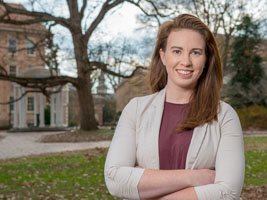
Horizon Award
Nearly 250,000 anterior cruciate ligament (ACL) injuries are estimated to occur annually in the United States, and the rate of pediatric ACL injuries has been documented as increasing during the past decade or so. Current treatments for pediatric ACL injuries are associated with recurring injuries and chronic arthritis in the long term. Researchers need more information on how the healthy ACL grows to create better treatments for children and adolescents.
Doctoral student Stephanie Cone, through pig model studies, investigated the structural, functional and biological changes in the knee during childhood growth. She worked with the UNC-Chapel Hill School of Medicine and the N.C. State University Comparative Medicine Institute, collaborating with animal scientists, veterinary medicine researchers and orthopedic surgeons. Their research revealed significant changes in the orientation of the ACL during growth in the pig (widely accepted as a good model of human knee structure and biomechanics).
Cone's imaging studies, using high-resolution MRI scanners at the UNC Biomedical Research Imaging Center, have shown that orientation and geometric proportions of the ACL depend on age. Both of these findings may impact clinical interventions, as graft placement and graft size are major variables in ACL reconstruction. Her team's functional analysis of the knee found that the distribution of forces within the ACL changes with age. Her findings suggest that reconstructions that return healthy function to adults may not offer complete replication of healthy function in pediatric patients.
Her work also advances a pre-clinical animal model with the same growth-related changes as humans, allowing researchers to optimize surgical techniques and develop novel solutions for orthopedic surgeries such as ACL reconstruction.
"Stephanie's research has considerable potential to impact the treatment of ACL injuries in youth sports, such as girls' soccer and basketball." said adviser Matthew Fisher, Ph.D.
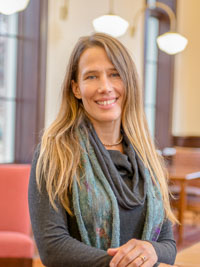
Impact Award
Health education provides students with guidance and tools about how to make healthy decisions. The N.C. Department of Public Instruction (NCDPI) established the Healthful Living Essential Standards toward this purpose. Prior to the work of recent master's degree graduate Julia Considine, no research addressed how these standards are implemented in N.C. schools.
Working in collaboration with the NCDPI's Healthy Schools Team, Considine focused on how Essential Standards are taught, who teaches them, what resources are used and what additional support is needed. Thirty-five administrators and educators, self-selected after contact with more than 200 individuals, were interviewed; interviewees represented each of the eight N.C. State Board of Education districts. While the questions address healthful living overall, there were also questions specifically regarding reproductive health and safety.
Considine's analysis of the extensive interviews identified barriers and supports within health education instruction, including the following:
Based on her study findings, Considine recommends separating health and physical education into semester– long courses offered each year, enhancing an online portal for resources and materials related to reproductive health and safety, and enhancing communication of that portal information to teachers and administrators. At the NCDPI's request, Considine is developing foundational content in the form of online modules about the Healthy Youth Act (including LGBTQ inclusivity), sexually transmitted diseases and healthy relationships that will support in-person training provided by the N.C. School Health Training Center, based at East Carolina University.
"As an outcome of Julia's findings, actions are under way to foster greater and equitable access to this vital health education across North Carolina." said adviser Lori Evarts, M.P.H.

Impact Award
Knowing the extent of HIV drug resistance in North Carolina is imperative for protecting patient health and controlling transmission of HIV in the community. However, drug resistance testing is not available for every patient. Under the mentorship of UNC-Chapel Hill professor Joseph Eron, M.D., and associate professor Sonia Napravnik, Ph.D., doctoral student Thibaut Davy-Méndez applied new methods previously created to compensate for missing patient data to determine the extent of HIV drug resistance among the patients in care at UNC Hospitals.
The UNC-Chapel Hill Center for AIDS Research has for many years collected medical information of patients living with HIV who are in care at UNC and have agreed to be included in research. More than 5,000 patients followed since 1996 are included. Davy-Méndez sought to estimate the number of UNC HIV patients with drug resistance every year from 2000 to 2016, determining changes over time and by class of HIV drug.
Davy-Méndez's analysis found that during the last 10 years, the prevalence of resistance to the three older drug classes has decreased in this clinical population but remains significant, between 15 percent and 30 percent, while resistance to the latest class of drugs has remained very low, at about 2 percent. His results suggest that in UNC's HIV clinical population, resistance may overall be less of a concern today than a decade ago, but is still a significant issue for some patients.
The study's preliminary results were presented at the Conference on Retroviruses and Opportunistic Infections in Seattle, an international conference on HIV, in early 2017. Davy-Méndez plans to share his finalized results with UNC HIV care providers and to submit a manuscript for publication in order to help inform clinical practice.
"Thibaut's work on HIV drug resistance is essential to informing clinical care management and public health guidelines." said adviser Sonia Napravnik, Ph.D.
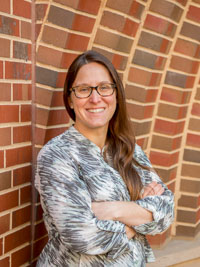
Impact Award
In the past few years, youth have led mobilization efforts around Black Lives Matter, the Fight for $15 and LGBTQ issues in North Carolina. How do organizations encourage this prominent youth engagement with politics, policies and communities? How does youth engagement benefit organizations and the young volunteers? Doctoral student Sarah Gaby completed a project with several components to find out.
She surveyed and analyzed responses from 71 youth-serving organizations in the Raleigh- Durham-Cary metropolitan area. She also observed, and conducted interviews and focus groups in four youth civic organizations. Her findings demonstrate that when youth are included in decision-making processes, they shape the organization's response to challenges; this makes the organization more inclined to respond to, instead of avoid, conflict.
Organizations that gave youth autonomy were found to have a deep engagement with the current discourse on racial inequality, compared to organizations that did not provide autonomy. Further, adults in more inclusive organizations indicated that they perceive their groups as more effective. Gaby's findings also indicate that youth in these types of organizations develop more enhanced civic skills that can be used in other ways.
She also analyzed the different organizational approaches to youth inclusion. Her data suggest that organizations have three major constraints in fully including youth: the organization's culture, the skills of the adult leaders and the diversity of the participants. Organizations that are more inclusive signal to participants an openness to youth influence, which can encourage engagement with diversity issues over time.
Gaby has provided feedback to the organizations she observed and has shared her results with the N.C. Center for Nonprofits. Her findings provide ways for organizations, policymakers and young volunteers to strengthen civic life in North Carolina.
"Sarah's multi-method study of youth organizations in the Triangle provides powerful insights for understanding how organizations can help youth become engaged citizens." said adviser Kenneth "Andy" Andrews, Ph.D.

Impact Award
The Research Triangle is one of the 25 fastest growing metropolitan areas in the country, according to the U.S. Census. As the population grows, however, even a moderate drought (such as the one currently impacting North Carolina) can strain existing water supplies. Extreme drought, such as the one experienced in 2007–08, can have severe economic consequences for the Triangle and create dangerous conditions for its citizens. In an effort to identify additional ways to maintain sufficient urban water supplies during droughts, doctoral student David Gorelick analyzed a potential low-cost drought mitigation option: raw, or untreated, water transfers between water utilities that lay along the same river.
Raw water transfers were included within a layered computational modeling framework of the Triangle region to simulate water utility decision-making under a wide range of future conditions. Gorelick and his collaborators compared model results with and without weekly raw water transfer sales from Durham to Raleigh and inter-utility cooperation through joint expansion of reservoir capacity in Durham's Lake Michie reservoir. Through an ongoing collaboration with UNC-Chapel Hill professor Gregory Characklis, Ph.D., necessary modeling data were provided by the four major water utilities of the Triangle (Cary, Durham, OWASA and Raleigh).
Findings demonstrated that raw water transfers between Raleigh and Durham could help to maintain regional supply reliability during droughts without the need for costly infrastructure or use restrictions. Additionally, the researchers found that Durham could maintain satisfactory levels of supply reliability despite occasional releases of water to Raleigh.
This work is part of an ongoing research collaboration involving UNC-Chapel Hill and Cornell University, and funded by the National Science Foundation, to design robust and adaptive water management strategies for regions transitioning into water scarcity.
"David's hard work and ingenuity are leading to more cost-effective and sustainable strategies for the Triangle and many other regions experiencing water scarcity." said adviser Gregory Characklis, Ph.D.

Horizon Award
As antibiotic resistance surges, the need for new antibiotics has become urgent. In the United States, antibiotic-resistant bacteria infect more than 2 million people each year. Interestingly, many bacteria naturally make compounds that have antibacterial activity. The actinomycetes, a group of bacteria that are commonly found in soil, are one of the largest sources for current antibiotics. These bacteria have the genomic potential to make even more antibiotics but in the laboratory, many of these potentially novel antibiotics are not made.
Doctoral student Gabrielle Grandchamp sought to mimic interactions that occur in the soil within a laboratory setting — in the hopes of uncovering interactions that will ultimately lead to the production of more actinomycete-based antibiotics. To do this, her team isolated actinomycetes from individual soil particles and then grew strains both alone (in monoculture) and paired with other bacteria found in the soil (in coculture). She then tested the monocultures and cocultures for antibiotic activity against Staphylococcus aureus (S. aureus).
Grandchamp and her colleagues identified several actinomycete pairs that were active against S. aureus only when grown together. Additionally, other samples showed low antibiotic activity in monoculture but increased antibiotic activity in coculture. She is now working with some of the cocultures of interest to determine what the antibiotics are.
While many public health measures can be taken to prevent further spread of antibiotic resistance, new strategies are needed to fight already existing antibiotic-resistant bacteria. The cocultures Grandchamp identified are active against an antibiotic-resistant strain of S. aureus. These antibiotics produced in coculture have the potential to be new therapies and this approach of culturing a bacterium with another bacterium from the same soil may help researchers discover new antibiotics in the future.
"Gabrielle's dedicated work on this project has already led to the identification of interactions that appear to generate novel antibiotic activity." said adviser Elizabeth Shank, Ph.D.

Impact Award
Charter schools are privately run public schools with open enrollment policies. Compared to traditional public schools, public charter schools have more flexibility in hiring, curriculum and use of funding. Proponents of charters say increased competition benefits traditional public school productivity, encouraging these schools to reallocate resources to increase efficiency and professional development for teachers. Opponents say competition from charters may drain resources and talent from traditional public schools, with implications for meeting state or federal standards.
Using administrative data covering all N.C. public school students from 1997 to 2016, doctoral student Joshua Horvath examined a specific issue related to the competition: the effects of charter schools on traditional public school student math and reading test scores.
N.C. House Bill 955, authorizing the establishment of charter schools, was ratified in 1996. Horvath analyzed competitive effects from 1997 to 2016 and how effects depend on the relative achievement of charter and traditional public schools. For the purposes of his study, a traditional public school was defined as competing with a charter school if traditional school students switched to a charter when they could have continued at the traditional school.
His findings indicate that, on average, charter schools have no effect on math test scores and a small positive effect on reading test scores. Competition from higher-achieving charter schools has a small positive effect on students in traditional public schools, while lower-achieving competition has zero to very small negative effects.
Horvath's research suggests that, at the least, students in traditional public schools are not hurt by — and may benefit from — competition with higher-achieving charter schools. His ongoing analysis has implications for leaders who are determining policies for all public schools.
"Josh's research is directly relevant to the debate around the funding and expansion of charter schools in North Carolina." said adviser Jane Cooley Fruehwirth, Ph.D.
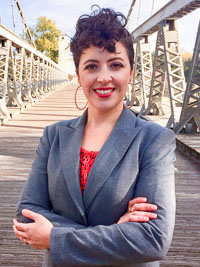
Impact Award
People who experience food insecurity report many undesirable experiences related to not having enough food: food shortages, prioritizing food quantity over quality, and feeling stressed and isolated. The U.S. Department of Agriculture (USDA) categorizes food insecurity by focusing mostly on reductions in food intake. Cassandra Johnson, Ph.D., developed a new alternative measure, named the Four Dimensional Food Insecurity Scale (4D-FIS), that captures additional aspects of food insecurity. While the 4D-FIS includes reductions in food intake, it is unique in assessing experiences related to food quality, stress and stigma. She then determined severity of food insecurity using both measures and compared them.
Her team interviewed 109 black, Latina and white female caregivers living in urban and rural areas of North Carolina. These women were enrolled in N.C. State University's Voices into Action: The Families, Food and Health Project, a USDA-funded research and outreach initiative focusing on childhood obesity. Johnson's team interviewed each woman three times. Participants also had their heights and weights recorded and gave detailed information about food and drink consumed over a 24-hour period.
Johnson's findings indicate that the 4D-FIS may better capture the full range of food insecurity experiences, from less to more severe. This is valuable for identifying people with unmet needs for food, especially those who may be missed using the USDA measure. By working with low-income families in North Carolina, Johnson has provided valuable knowledge to help community organizations and local government — and help more people access the food they need to be healthy and active.
"Cassandra's research is addressing the longstanding need to improve the current, and now outdated, measures of food insecurity." said adviser Alice Ammerman, Dr.P.H.
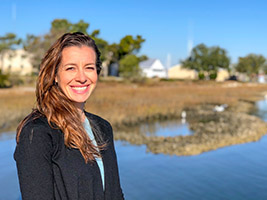
Impact Award
North Carolina has an expansive estuarine system with many critical habitats for young fishes and crabs. However, estuaries are also among the most degraded ecosystems on the planet. The loss of habitats, such as oyster reefs, salt marshes and seagrass beds, has impacted the nursery-related functions of our estuaries, which is a major economic and environmental concern in North Carolina. Doctoral student Danielle Keller led three efforts to better understand links among habitat quality, availability and fishery production.
Specifically, she monitored species density and foraging behavior to determine how fauna respond to changes in habitat availability. Keller determined which species of fishes and crabs appear to benefit most from increasing the amount of structurally complex habitat within the estuary. In turn, these findings provide insight into how declines in estuarine habitats may have reduced the fishery production of North Carolina's coastal ecosystems.
Keller also led an effort to restore oyster reefs along different types of salt marsh shorelines, and found that the shoreline with the lowest wind and wave energy supported higher adult oyster densities.
Lastly, Keller monitored the density and movement of fishes in different types of seagrass beds, finding a strong decline in fish densities coinciding with a seasonal decline in eelgrass cover, even as another species, shoalgrass, increased in cover. As eelgrass finds its southern range limit in North Carolina and experiences seasonal thermal stress, these data highlight how climate change may impact fishery production in our estuaries.
Taken collectively, state managers and the N.C. Coastal Reserve and National Estuarine Research Reserve will be able to leverage Keller's findings to better design restoration projects to maximize fisheries production and shoreline protection for coastal citizens.
"I expect that Danielle's work will be influential in the next draft of North Carolina's detailed Coastal Habitat Protection Plan in terms of oyster reef and seagrass management." said adviser Joel Fodrie, Ph.D.
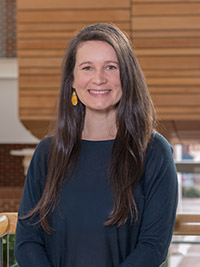
Impact Award
In 1999, the N.C. Department of Health and Human Services (DHHS) began collecting extensive data on tobacco use among middle and high school students. Every other year, DHHS conducts the N.C. Youth Tobacco Survey — a state survey of between 7,000 and 8,000 youth — and respondents' answers provide key information on changes in tobacco use within this population. One finding from the 2015 survey: Overall current tobacco use among high school students increased from 22.5 percent in 2011 to 27.5 percent in 2015.
Doctoral student Sarah Kowitt began analyzing survey data in 2014, through a collaboration with DHHS and UNC-Chapel Hill's family medicine department. She has analyzed three waves of data (2011, 2013 and 2015) to provide insights central to tobacco education and prevention efforts.
After analyzing the data, Kowitt was responsible for sharing the findings through peer-reviewed research articles, and presentations at national conferences and with state DHHS officials. For example, she led what is believed to be the first study examining e-cigarette use among youth not susceptible to smoking cigarettes. She found that youth who perceived e-cigarettes as less harmful and youth who reported exposure to e-cigarette vapor at home or in public places were likelier to use e-cigarettes.
She also was a co-author on research documenting the growing prevalence of e-cigarette use (from 1.7% in 2011 to 7.7% in 2013) and hookah use (from 3.6% in 2011 to 6.1% in 2013) within this population. The team's research determined that students who used both e-cigarettes and cigarettes were less likely to intend to quit cigarette smoking.
Kowitt's work continues to help DHHS use its strong survey data to identify subgroups in need of tailored programs, and pinpoint ways that practitioners and tobacco control advocates can intervene to reduce youth tobacco use.
"Without Ms. Kowitt, our research team and our state would lack critical knowledge to advocate for resources to prevent future generations of youth from using tobacco." said adviser Adam Goldstein, M.D.
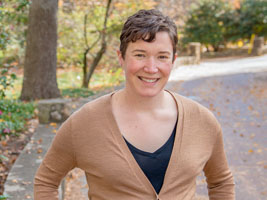
Impact Award
Hurricanes and tropical storms — such as hurricanes Floyd and Matthew — have caused devastating loss of life and property in North Carolina. After Hurricane Floyd hit in 1999, the State of North Carolina administered a Federal Emergency Management Agency program that purchased the homes of 4,500 households in floodplains. Doctoral student Amanda Martin analyzed how post-Floyd buyouts affected the economic well-being of households and communities. She focused on the long-term recovery of residents in two small African-American communities: Princeville and Lincoln City, a neighborhood of Kinston. Princeville declined buyout and relocation, and 97 percent of eligible Lincoln City sellers participated.
Her study findings indicate that buyouts created a significant opportunity for individual homeowners, particularly to move to a neighborhood perceived as higher quality, into better homes, or to a city with more jobs. However, the buyouts caused the loss of community social ties that had provided economic value to residents, such as shared carpooling and childcare. Individuals interviewed as a part of the study reported that this translated into lost jobs for former Lincoln City residents and higher crime in the areas surrounding the buyouts. Renters in buyout areas experienced a lack of housing options, and many turned to subsidized housing.
Martin has shared her ongoing study results with the Hurricane Matthew Disaster Recovery and Resilience Initiative, directed by UNC-Chapel Hill professor Gavin Smith, Ph.D., providing insights to improve buyout implementation in the aftermath of that storm — and the others to come.
"Helping socially vulnerable communities bounce back better from disasters is the driving focus of Amanda's research." said adviser Mai Thi Nguyen, Ph.D.
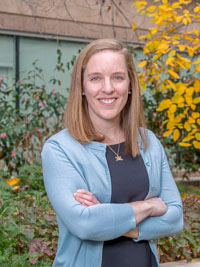
Impact Award
Infertility is a common, devastating clinical problem that affects millions of women nationwide. The capacity of the uterus to accept an implanting embryo is a critical component of establishing a healthy pregnancy. Little is understood about the molecular mechanisms of this particular process, and even "last-line" assisted reproductive technology cannot overcome this issue. M.D./Ph.D. student Brooke Matson has discovered, through a mouse model study, how administration of a hormone called adrenomedullin (AM) can improve embryo implantation in the context of assisted reproduction.
Levels of AM increase five-fold during a healthy pregnancy. This hormone originates from both the mother and fetus, and contributes to establishing and maintaining a healthy pregnancy in both mice and humans. During the past decade, mouse model studies from the lab of UNC-Chapel Hill professor Kathleen Caron, Ph.D., have demonstrated that female mice expressing one-half of the normal levels of AM demonstrate below normal levels of fertility. Her lab's data suggest that administering AM in early pregnancy may improve fertility and lead to better pregnancy outcomes.
Matson focused on understanding the changes AM produces that improve the uterus's capacity to accept an implanting embryo. In collaboration with Caron lab members and pharmaceutical partners, Matson demonstrated that administration of AM to the uterus promotes beneficial structural changes to the uterine lining that are conducive to implantation. Given that administration of AM is localized, widespread systemic effects on blood pressure and other systems are avoided.
Their discoveries have implications for developing promising therapeutics for infertility.
"Brooke's findings may eventually provide new therapies for the greater than 200,000 women in North Carolina struggling with fertility problems." said adviser Kathleen Caron, Ph.D.
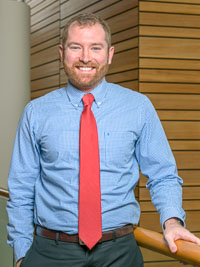
Horizon Award
Obesity is an established risk factor for breast cancer and is associated with its spread, which causes 90 percent of deaths associated with breast cancer. The exact mechanisms linking obesity and the spread of cancer to distant areas of the body, known as metastasis, are unknown; however, the lab of professor Stephen Hursting, Ph.D., has produced research suggesting inflammation as a key factor.
Hursting's lab group showed that mice fed a high fat diet became obese. When these mice were injected with breast cancer cells, they were more likely to develop lung metastases than non-obese mice that had been fed a low-fat diet and injected with breast cancer cells. Additionally, those mice on the low-fat diet lived significantly longer than mice fed the high-fat diet.
Working within Hursting's lab group, M.D./Ph.D. student Shan McDonell developed a mechanism to test an anti-inflammatory compound's effectiveness in reducing obesity-related increases in metastasis. McDonell and his collaborators supplemented mice on the low-fat or obesity-inducing diets with an anti-inflammatory drug that acts similarly to aspirin. He found that mice on the high-fat diet with the anti-inflammatory drug had tumor sizes no different than mice on the low-fat diet — and significantly smaller than those on the high-fat diet without the anti-inflammatory drug. Similarly, the drug also reduced the higher burden of lung metastases seen in obese mice.
His findings demonstrate that the drug blocks obesity's pro-growth and pro-metastatic effect on tumors. McDonell's current project is further evaluating how anti-inflammatory drugs decrease metastatic capabilities of breast cancer cells, and what genes might be important in this process. Additionally, his experiments are examining different tumor types, as no two patients' breast cancer are exactly alike. Taken together, this work has strong implications for one day identifying gene targets that will help break the link between obesity and breast cancer metastasis.
"If Shan's targeted strategy using safe, inexpensive drugs like aspirin reduces obesity-associated breast cancer deaths by 25 percent (a conservative estimate based on his preliminary data), that could save the lives of 500 women in North Carolina per year." said adviser Stephen Hursting, Ph.D.
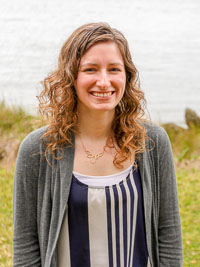
Impact Award
Traditionally, coastal residents and municipalities have fought shoreline erosion with bulkheads, groins and jetties. Living shorelines are currently gaining popularity as a sustainable and effective alternative. In North Carolina, living shorelines typically incorporate salt marsh grass bordered by hard materials such as oyster reefs or rocks.
Recent master's degree graduate Kathleen Onorevole analyzed another potential benefit of living shorelines: moderating nitrogen concentrations in coastal waters. A range of human activities can contribute to nitrogen loading in estuarine and marine habitats, where nitrogen can fuel rapid algae growth that poses risks to human health and aquatic life. One way to limit this chain of events is by encouraging conditions that support denitrification, a natural process that reduces nitrogen concentrations.
Onorevole quantified the development of denitrification in living shorelines over time by conducting seasonal field sampling at four living shorelines, constructed up to 20 years earlier, located near the UNC Institute of Marine Sciences. Her findings showed that denitrification rates increased during the first seven years following construction and were sustained afterward.
Onorevole did not find significantly different denitrification rates between the oyster reef and salt marsh habitats, indicating that the living shorelines functioned as a unit in terms of nitrogen removal. In addition, she did not detect notable production of nitrous oxide, a greenhouse gas sometimes associated with denitrification.
In early 2017, the U.S. Army Corps of Engineers revised the national permitting process for living shorelines, making it easier for a resident to construct one on his or her property. Onorevole has provided new data — and at a critical time — on how living shorelines can moderate nitrogen cycling and sustain water quality.
"Kathleen's study generated actionable information that will enhance our ability to sustain both water quality and coastal shorelines." said adviser Michael Piehler, Ph.D.

Impact Award
North Carolina's fishing industry provides 25,000 jobs and annual economic benefits exceeding $4 billion, according to 2015 N.C. Division of Marine Fisheries statistics. This industry depends on reefs — including rocky reefs, shipwrecks and artificial reefs — that sustain fish populations. These reefs are at risk as humans are increasingly working in proximity to them to harness energy, protect shorelines and foster ecotourism. Doctoral student Avery Paxton investigated how fish within reef habitats might respond to human activities.
She used scuba-diver surveys, video cameras and underwater microphones, and instruments mounted on research ships to conduct five studies. In one study, her team monitored a rocky reef 's fish population when exposed to underwater noises typically emitted when searching for oil and gas deposits below the seafloor. Paxton found that the fish population declined 78 percent in evening hours when the noises were present.
Paxton also determined that human-made reefs, such as offshore wind turbine bases, may enable fish to move poleward and deeper to escape stressors from warming water temperatures experienced with climate change. Based on Paxton's discovery, university researchers and government officials are exploring ways to strategically place human-made structures already slated for deployment to also sustain vulnerable fish.
Her team found that flat and complex reefs provide similar support for fish. Traditionally, officials have thought that the most complex reefs needed the most protection from potentially harmful development; Paxton's findings indicate that flat reefs need protection, as well.
Her other research demonstrated that human-made reefs can support high concentrations of valuable fish within months of being established. Taken together, her findings provide strong insights to guide management and conservation decisions focused on preserving fish habitats amid increasing human activities in the Atlantic.
"Avery's multiple findings are ensuring that reefs continue to house and serve fishes that are so valuable for the myriad fish-related industries in North Carolina." said adviser Charles "Pete" Peterson, Ph.D.

Impact Award
Hearing loss is sometimes more strongly associated with advanced aging. Yet an estimated 12 percent of hearing loss for females and 11 percent of hearing loss for males occur between the ages of 6 and 19, according to the National Institute on Deafness and Other Communication Disorders.
School-aged children with hearing loss face challenges in language and literacy, and spelling is identified as one particular challenge. Despite the commonly held belief that spelling is a rote memory skill, a growing body of research supports the view that spelling is a language skill. Key aspects of spelling such as speech sounds, written representations of words and word meanings pose challenges for children with hearing loss. Much is unknown about why these children struggle with spelling.
Nancy Quick, Ph.D., developed a tool to assess language-related sources of spelling errors among N.C. children with hearing loss. Her research also contributes vital knowledge about how the level of aided hearing and the type of hearing technology contribute to spelling errors. For example, her findings indicate that children with poorly fitted hearing aids (with insufficient access to all frequencies needed for speech) and with cochlear implants have higher percentages of errors involving speech sounds.
Her study is believed to be the first multilinguistic analysis of spelling among students with all degrees of hearing loss. The assessment tool she created is being shared with UNC-Chapel Hill graduate clinicians in speech-language pathology and audiology, who will eventually serve children with hearing loss in N.C. schools. Quick, who volunteers with N.C. programs for families of children with hearing loss, is also sharing her results within the state and at national conferences.
"Nancy has translated her approach into a tool that will allow speech-language pathologists to work with teachers to address the children's spelling challenges." said adviser Karen Erickson, Ph.D.
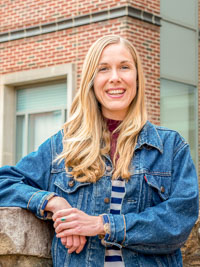
Impact Award
North Carolina is the nation's second largest producer of hogs for meat consumption, according to the U.S. Department of Agriculture's National Agricultural Statistics Service. Industrial hog operations, where the majority of N.C. hogs are raised, routinely administer antibiotics to hogs to treat disease, prevent disease and maximize growth. This has contributed to the emergence of antibiotic-resistant bacteria within livestock and has generated concerns about possible transmission to humans.
To address these concerns, doctoral student Sarah Rhodes and her team compared the prevalence of antibiotic-resistant bacteria, Staphylococcus aureus (S. aureus), in swine, air and the breathing zone of researchers performing animal handling activities (worker surrogates) at one industrial hog operation (IHO) and three pasture-based, antibiotic-free hog operations (AFHO) in North Carolina. Collaborators at Johns Hopkins University and N.C. Choices, an initiative of the N.C. State University Center for Environmental Farming Systems, led recruitment of the operations.
Rhodes collected and processed the air and worker surrogate samples for the study. Certified veterinarian Meghan Davis, Ph.D., of Johns Hopkins collected samples from 20 IHO swine and 30 AFHO swine.
Rhodes' team found that 85 percent of IHO swine and 57 percent of IHO air samples tested positive for S. aureus, compared to no positive samples within the AFHOs. Within the IHO samples, 97 percent of S. aureus from swine, 100 percent of S. aureus from the air and 100 percent of S. aureus from worker surrogates were resistant to three or more classes of antibiotics.
Her results suggest that IHO workers may be exposed to antibiotic-resistant, livestock-associated S. aureus. Rhodes is working with N.C. Choices and the Rural Empowerment Association for Community Help to inform IHOs, AFHOs and communities in North Carolina about the implications of antibiotic use in hog production.
"Sarah is answering questions of global importance, all while studying local sites and in direct consideration of people affected by disproportionate environmental and health impacts." said adviser Jill Stewart, Ph.D.
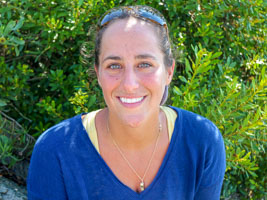
Impact Award
North Carolina's coastline is increasingly vulnerable to sea level rise, storm surge and erosion. A prevailing strategy has been to armor shorelines with hard engineered structures, such as bulkheads or seawalls. Nationally, an estimated 14 percent of shoreline is "hardened" — yet this approach can harm coastal habitats that support fish and can fail during major storms. Environmental engineers advocate for living shorelines, which incorporate natural elements.
Doctoral student Carter Smith sought to integrate socioeconomic and ecological data on the consequences and effectiveness of shoreline hardening. She assessed how bulkheads, natural marshes and living shorelines along close to 19 miles of N.C. coastline changed after Hurricanes Irene (2011), Arthur (2014) and Matthew (2016). She also surveyed more than 600 N.C. waterfront homeowners on their decisions related to protecting shoreline within their property and costs associated with shoreline maintenance (normal and hurricane-related expenditures).
Her homeowner survey data suggest that when choosing how to protect their shorelines, N.C. waterfront homeowners prioritize cost, durability and effectiveness at preventing erosion, and that environmental impact is rarely a priority. They further indicate their belief that bulkheads are the most effective and durable option available to them. Smith's ecological findings demonstrate that hardened shorelines sustain more hurricane damage and are four times more costly to maintain than natural shorelines. In fact, about 20 percent of bulkheads were damaged after each hurricane her team studied.
Smith's findings suggest that living shorelines can protect property during storm events at a significantly lower cost than traditional hardened shorelines. Additionally, living shorelines can sustain and enhance coastal habitats and the economies they support. Her research is vital in helping property owners and coastal managers reduce erosion-related costs in the future.
"Carter's research has critical implications for coastal management at a time when implementation of hard engineered shoreline protection structures is rampant." said adviser Charles "Pete" Peterson, Ph.D.

Horizon Award
Autoimmune diseases occur when the body's immune system identifies healthy cells as foreign and attacks those cells. Inflammatory bowel disease, rheumatoid arthritis and dozens of other autoimmune diseases have been identified, and they affect the lives of millions of Americans. Current treatments, while effective, place patients at risk of significant side effects.
The laboratory of UNC-Chapel Hill professor Ronald Falk, M.D., has been studying the development of a family of rare autoimmune diseases called anti-neutrophil cytoplasmic autoantibody (ANCA) vasculitis for 30 years. Doctoral student Katie Stember is investigating the specific cell-to-cell interactions that lead to ANCA vasculitis, with the goal of developing more effective and targeted medications for these patients.
ANCA vasculitis centers on the immune system's targeting of two self-proteins, myeloperoxidase (MPO) or proteinase 3 (PR3) – located on immune cells. This targeting activates the immune cells and causes collateral damage to blood vessels throughout the body, ultimately leading to chronic inflammation of the lungs and kidneys. Stember primarily focuses on MPO and she collected blood samples from patients with MPO-ANCA vasculitis for her studies.
Her experiments confirmed that a specific region of MPO is being recognized by immune cells known as T cells. Using this specific region of MPO as bait, she was able to isolate and characterize these faulty T cells compared to healthy T cells. Stember further characterized a functional response that directly implicates the faulty cells in the inflammation process.
The work of Stember's team opens several new avenues of investigation, and her findings will inform the development of new treatments for patients with ANCA vasculitis and other autoimmune diseases.
"Katie's research is an important next step in our decades-long research into these rare and complicated kidney diseases, and will lead to improved therapies." said adviser Ronald Falk, M.D.

Impact Award
Badin has a population of nearly 2,000 and a history in which Alcoa, formerly known as the Aluminum Company of America, has played a defining role. Badin was a "company town"; Alcoa was the proprietor and de-facto government for the town through much of Badin's history. In the aftermath of the closing of the Alcoa Badin Works aluminum smelting plant, residents are negotiating concerns with environmental contamination and racism. Doctoral student Pavithra Vasudevan — working directly with black residents of Badin — integrates scholarship from black studies and environmental studies to explore how racism and toxic exposure have converged in the area encompassing the aluminum smelter, the adjacent residential neighborhoods and the landscape.
Vasudevan developed an oral history project in collaboration with Naeema Muhammad, co-director and community organizer for the N.C. Environmental Justice Network, and the Concerned Citizens of West Badin Community, a grassroots organization that addresses racial exclusion, environmental contamination and health concerns. Vasudevan wrote the script for a research play incorporating oral histories, her observations of community meetings and archival materials. That play, titled Race and Waste in an Aluminum Town, has been staged for local and regional audiences, and continues to be revised based on audience and community feedback.
Vasudevan is now collaborating with UNC-Chapel Hill epidemiology doctoral student Libby McClure to explore the health impacts of occupational toxicity on workers and their families in Badin. They will analyze records gathered by Alcoa in their smelting plants, archival materials from the United Steelworkers union and a household survey to be developed with the local community.
Vasudevan's collaborative research seeks to support Badin residents in their fight for justice, and is relevant to other communities struggling with issues of racism and environmental contamination.
"Pavithra's graduate career has been dedicated to working alongside community groups in North Carolina to further their attempts to gain justice for family members suffering illness due to exposure to chemicals in the environment." said adviser Sara Smith, Ph.D.

Impact Award
North Carolina has a sufficient number of physicians but faces a critical issue in the unequal distribution of physicians, according to 2015 UNC-Chapel Hill Sheps Center for Health Services Research findings. In an effort to understand location and specialty maldistribution of N.C. physicians, doctoral student Teresa Zhou evaluated influential geographic and professional factors to ultimately inform policies on what attracts physicians to underserved communities — and encourages them to stay.
She used a model analyzing individual behavior over time, incorporating data from all physicians licensed to practice in North Carolina from 2003 to 2012. She examined determinants of professional behaviors, including individual demographics, wages, county amenities and characteristics of medical care demand. Using the model, Zhou simulated short- and long-term effects of policy interventions.
Zhou's findings indicate that loan forgiveness policies, simulated as a lump sum increase in wages for all rural physicians, do not significantly decrease likelihood of movement nor do they increase the average stay in rural areas. However, an increase in the reimbursement rate, or a simulated 5 percent increase in average wages for all rural physicians, increases the average stay in the same rural county by 1.34 years.
Other findings:
Zhou's evaluations provide key information aimed at cost-efficient policies that encourage physician presence in underserved areas.
"Teresa's work quantifies the impacts of important economic determinants — including compensation, medical care market characteristics and local amenities — that define concerns about our state's physician maldistribution." said adviser Donna Gilleskie, Ph.D.